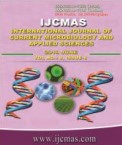


 National Academy of Agricultural Sciences (NAAS)
National Academy of Agricultural Sciences (NAAS)

|
PRINT ISSN : 2319-7692
Online ISSN : 2319-7706 Issues : 12 per year Publisher : Excellent Publishers Email : editorijcmas@gmail.com / submit@ijcmas.com Editor-in-chief: Dr.M.Prakash Index Copernicus ICV 2018: 95.39 NAAS RATING 2020: 5.38 |
In Groundnut aflatoxin contamination is a major problem which affects the quality of the seed. These aflatoxins have carcinogenic, hepatotoxic, teratogenic and immuno-suppressive effects which were produced by Aspergillus flavus and A. parasiticus. For the management of aflatoxin problem in groundnut, use of plant growth-promoting rhizobacteria (PGPR) is a viable and sustainable option. Our present study is aimed at determining the mode of action of these PGPR (Pseudomonas fluorescens) using Scanning Electron Microscope (SEM). A superior P. fluorescens isolate (Pf7) identified from our studies in dual culture studies and in vitro seed colonization assay (IVSC) was screened against toxigenic isolate of A. flavus (AFT5B). In SEM, Pf7 exhibited both antibiosis and hyperparasitism. In antibiosis, deformation and coiling of hyphae of test fungus was noticed. Further, the mycelium appeared thread like, wrinkled and flaccid. Conidiophores are twisted near the zone of inhibition. In hyperparasitism, a white slimy growth of bacterial cells was seen on mycelia of test fungus. Further, structural disintegration of conidiophores and conidia of A. flavus was noticed. Overall, our results suggested the efficacy of Pf7 in reducing A. flavus infection and aflatoxin contamination through hyperparasitism and antibiosis.
 |
 |
 |
 |
 |